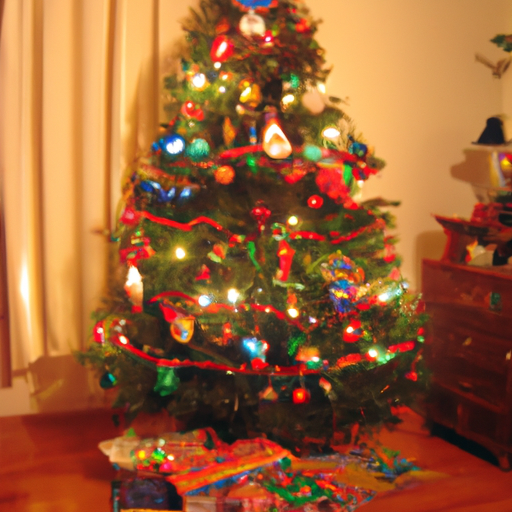
Imagine creating a stunning Christmas card from scratch with just a few simple materials! In this article, you will discover step-by-step instructions on how to craft a beautiful greeting card featuring a festive Christmas tree. With its easy-to-follow guide and minimal supplies needed, this DIY project is perfect for anyone who wants to add a personal touch to their holiday greetings. Get ready to impress your loved ones with a handmade card that will truly make their Christmas extra special.
Materials Required
List of Materials
To make a greeting card with a Christmas tree, you will need a few materials. These include:
- Cardstock
- Scissors
- Glue
- Decorative materials (such as ribbons, glitter, and stickers)
- Markers or pens for writing the message
- Envelope for packaging and delivery
Make sure you have all these materials handy before you begin, so you don’t have to search for them while working on your card.
Affordable Options
If you’re on a budget or prefer affordable options, there are plenty of choices for materials that won’t break the bank. Look for discounted cardstock packs or consider using recycled paper for a more eco-friendly option. For decorative materials, browse your local dollar store for affordable ribbons, stickers, and glitter.
Environmental Considerations for Materials
When choosing the materials for your greeting card, it’s important to consider the environmental impact. Opt for cardstock that is made from recycled or sustainable sources. Look for eco-friendly glues and markers that are non-toxic. By choosing environmentally friendly materials, you can create a beautiful card while minimizing your carbon footprint.
Choosing the Right Cardstock
Types of Cardstock
Cardstock comes in various types, each with its own characteristics and thickness. The most common types of cardstock include matte, glossy, and textured. Matte cardstock has a smooth finish and works well for most greeting cards. Glossy cardstock has a shiny appearance, which can add a touch of elegance to your card. Textured cardstock adds a unique visual and tactile element to your design.
Consider the type of cardstock that best suits your design and the message you want to convey. Experiment with different options to see which one works best for your project.
Choosing Cardstock Color
Cardstock is available in an array of colors, allowing you to select the perfect shade for your Christmas tree greeting card. Traditional colors such as green, red, and gold are often used for Christmas-themed cards. However, you can also opt for other colors that complement your design or match the recipient’s preferences.
Think about the overall aesthetic you want to achieve and consider the recipient’s personality and preferences when choosing the cardstock color.
Where to Buy Cardstock
Cardstock can be purchased from a variety of sources. Many craft stores carry a wide selection of cardstock in different colors and finishes. Online retailers and stationery shops also offer a range of options. Consider browsing different stores or websites to compare prices and find the best deal for the cardstock that meets your requirements. If you’re in a pinch, you may even find cardstock at your local office supply store.
Designing the Christmas Tree
Creating a Rough Sketch
Before diving into the actual design process, it’s helpful to create a rough sketch of your Christmas tree greeting card. Take a blank piece of paper and sketch out the basic shape of a Christmas tree. This will give you a visual reference and help you plan the layout of your card.
If you’re not confident in your drawing skills, you can also find printable templates online that you can trace or use as a starting point for your design.
Selecting Tree Design
Once you have your rough sketch, it’s time to decide on the specific design elements for your Christmas tree. Consider whether you want a simple silhouette or a more detailed tree with branches and ornaments. Think about the overall style of your card and how the tree will fit into the overall composition.
You can also add other elements to your tree, such as presents, snowflakes, or stars. Be creative and let your imagination guide you in selecting the perfect design for your card.
Choosing Colors for the Tree
When it comes to choosing the colors for your Christmas tree, you have numerous options. Traditional green is a popular choice, but don’t be afraid to experiment with different shades or even non-traditional colors.
Consider the color scheme of your overall design and select colors that complement each other. You can use markers, colored pencils, or even cut out colored paper to add depth and vibrancy to your tree.
Cutting Out the Christmas Tree
Safety Precautions while Cutting
When working with scissors, it’s essential to prioritize safety. Make sure the scissors you are using are sharp and in good condition. Dull scissors can be more difficult to control and may cause accidents.
Always cut away from your body and keep your fingers away from the blade. Take breaks if your hand gets tired to avoid accidental slips or cuts. If you’re working with children, supervise them closely to ensure they are using scissors safely.
Technique for Cutting the Tree
Using your rough sketch as a guide, carefully cut along the outline of your Christmas tree. Take your time and follow the lines as accurately as possible. If you’re working with a more intricate design, consider using small, sharp scissors or even a craft knife for precision.
Remember to cut out any additional elements, such as presents or ornaments, that you want to include in your card. A pair of small, sharp scissors can be invaluable for detailed cutting.
Finishing Edges
After cutting out the Christmas tree and other elements, you may notice rough or uneven edges. To give your card a polished look, consider using a fine-grit sandpaper or an emery board to smooth out any imperfections.
Alternatively, you can use decorative scissors with unique edges to add an extra touch of flair to the edges of your card. This can create interesting patterns and textures that enhance the overall design.
Decorating the Christmas Tree
Choosing Decorative Materials
Now that you have your cardstock and tree cut out, it’s time to decorate your Christmas tree. Consider using various decorative materials to bring your tree to life. Some popular options include ribbons, glitter, beads, sequins, and stickers. You can also use small pieces of colored paper to create ornaments or garlands for your tree.
Think about the overall aesthetic you want to achieve and the recipient’s preferences when choosing the decorative materials. You can go for a classic and elegant look or a festive and playful design.
Decorative Techniques
There are countless ways to decorate your Christmas tree greeting card. Here are a few techniques you can try:
- Gluing ribbons in a wavy pattern to mimic garlands
- Adding small beads or sequins as embellishments
- Using glitter to highlight certain areas of the tree
- Using markers or colored pencils to draw ornaments or patterns on the tree
- Using stickers to add festive images or messages
Remember to consider the balance and harmony of your design as you decorate the tree. Don’t overcrowd the tree with too many decorations, but also make sure it doesn’t appear too bare.
Adding the Finishing Touches
To complete your Christmas tree greeting card, consider adding some finishing touches. You can write a festive message on the cardstock, such as “Merry Christmas” or “Season’s Greetings,” using markers or pens. You can also add additional elements like a star on top of the tree or a snowy landscape at the bottom.
Be creative and personalize the card to make it extra special for the recipient. Don’t forget to sign your name and date the card for a personal touch.
Writing the Message
Deciding on a Personal or General Message
When writing the message for your Christmas tree greeting card, consider whether you want to go with a personal or general message. A personal message can include specific details about your relationship with the recipient or reference shared memories. A general message, on the other hand, is more suitable for acquaintances or professional relationships.
Think about the recipient and the nature of your relationship when deciding on the tone and content of your message.
Adding Individual Touches
To make your message more personal, consider adding individual touches. These can include inside jokes, compliments, or well wishes for the recipient. Think about what makes the recipient special and incorporate those elements into your message. Personal touches show that you’ve put thought and effort into creating the card.
Ensuring Legibility of the Message
To ensure that your message is easily readable, pay attention to the size and style of your handwriting. Use a pen or marker that contrasts with the color of the cardstock for better visibility. If you’re concerned about your handwriting, you can also print or type out your message and glue it to the inside of the card.
It’s important that the recipient can easily read and understand your message, so take your time to write it neatly.
Adding Additional Elements
Using Ribbons and Glitter
To add an extra touch of elegance or sparkle to your Christmas tree greeting card, consider using ribbons and glitter. Ribbons can be used to create bows or borders around the card, enhancing its visual appeal. Glitter can be sprinkled on the tree or the card itself to create a magical and festive effect.
Remember to use glue sparingly when adhering ribbons and glitter to prevent the card from becoming too bulky or messy.
Incorporating Pop-Up Elements
Pop-up elements can add a delightful surprise to your Christmas tree greeting card. You can create pop-up presents, a pop-up star atop the tree, or even a pop-up snowflake. There are various templates and tutorials available online that can guide you in creating these fun and interactive elements.
Make sure to carefully follow the instructions and practice folding and assembling the pop-up elements before attaching them to the card.
Inclusion of Additional Graphics
In addition to the Christmas tree, consider adding other graphics that complement your design. You can include images of Santa Claus, reindeer, snowmen, or other festive symbols. Stickers, printed images, or even hand-drawn illustrations can be used to incorporate these additional graphics.
Remember to maintain a cohesive and balanced design by ensuring that the added graphics enhance the overall theme of your Christmas tree greeting card.
Preserving the Card
Choosing Right Adhesives
To ensure that your Christmas tree greeting card remains intact, it’s important to use the right adhesives. Consider using glue sticks or double-sided tape for attaching decorative materials or additional elements to your card. These adhesives provide a strong bond without causing any damage to the cardstock.
Avoid using excess amounts of glue or adhesive that could seep through the cardstock, causing unsightly stains or warping.
Advice on Storing the Card
To preserve your Christmas tree greeting card for future enjoyment, it’s crucial to store it properly. Keep the card in a clean and dry environment to prevent any moisture or dirt from damaging the cardstock or decorations. Consider placing the card in a protective sleeve or envelope to prevent it from getting bent or torn.
It’s also a good idea to store the card in a box or album specifically designed for greeting card preservation. This will help keep it organized and protected from external elements.
Ensuring Longevity
If you want your Christmas tree greeting card to last for many years, consider using high-quality materials and techniques during the crafting process. Opt for acid-free and archival-quality cardstock to prevent yellowing or deterioration over time. Use markers or pens that are fade-resistant for the message and decorations.
Taking these measures will help ensure that your card remains vibrant and beautiful for years to come.

Final Presentation and Packaging
Selecting the Perfect Envelope
When presenting your Christmas tree greeting card, it’s important to choose the perfect envelope. Consider a color that matches or complements the cardstock. Ensure that the envelope is the appropriate size to accommodate the dimensions of your card. Look for envelopes that are made from recycled or eco-friendly materials for a more sustainable choice.
You can also consider adding a personal touch by decorating the envelope with stickers, stamps, or a handwritten address.
Wrapping the Card
To protect your Christmas tree greeting card during transit or gifting, you can wrap it in tissue paper or cellophane. This will prevent any damage or smudging of the card during handling. If you prefer, you can also use a decorative gift box or a clear plastic box to showcase the card.
Consider the recipient’s preferences and the occasion when deciding on the most suitable wrapping option.
Ensuring Safe Delivery
When mailing your Christmas tree greeting card, it’s important to take steps to ensure safe delivery. Place the card in its envelope or wrapping and seal it securely. Use proper postage and clearly address the envelope. If you’re mailing multiple cards, consider using padded envelopes or bubble mailers for added protection.
If possible, send your card with a tracking number to monitor its progress and ensure it reaches its destination on time.
Common Mistakes to Avoid
Top Mistakes in Cardmaking
While creating your Christmas tree greeting card, it’s helpful to be aware of common mistakes that can be easily avoided. Some top mistakes to watch out for include:
- Using too much glue or adhesive, which can cause smudging or rippling of the cardstock
- Overcrowding the card with too many decorations, making it appear cluttered and messy
- Forgetting to plan the design before cutting, leading to uneven or imbalanced results
- Failing to proofread the message for spelling or grammar errors
- Rushing the cutting or decoration process, leading to sloppy or inaccurate results
How to Fix Common Mistakes
If you make a mistake while creating your Christmas tree greeting card, don’t panic. Many mistakes can be fixed or corrected. Here are a few tips to help you remedy common errors:
- If you’ve used too much glue, gently dab a clean tissue or cloth onto the affected area to absorb the excess adhesive.
- If the decorations appear cluttered, carefully remove some of the excess elements and rearrange them for a more balanced look.
- If you’ve cut or folded incorrectly, consider covering up the mistake with additional decorations or elements.
- If there are spelling or grammar errors in the message, carefully scrape off the incorrect writing and rewrite the text.
Remember, mistakes are a part of the creative process, and they can often be turned into opportunities for unique and innovative designs.
Preventive Measures to Avoid Mistakes
To minimize the occurrence of mistakes while making your Christmas tree greeting card, it’s important to take certain preventive measures. Here are some tips to help you avoid common errors:
- Prepare all your materials and tools in advance to ensure you have everything you need within reach.
- Take your time during each step of the process, focusing on accuracy and precision.
- Plan your design before cutting or decorating to avoid any surprises or mistakes.
- Proofread the message and double-check the spelling and grammar before writing it on the card.
- Follow instructions and tutorials carefully and practice techniques before implementing them on the actual card.
By being prepared, patient, and thorough, you can increase your chances of creating a beautiful and error-free Christmas tree greeting card.
In conclusion, making a greeting card with a Christmas tree can be a fun and rewarding project. By following the step-by-step guide and utilizing the various tips and techniques provided, you can create a personalized and meaningful card for your loved ones. Remember to choose the right materials, plan your design, and pay attention to details to ensure a successful outcome. Happy card-making and happy holidays!




